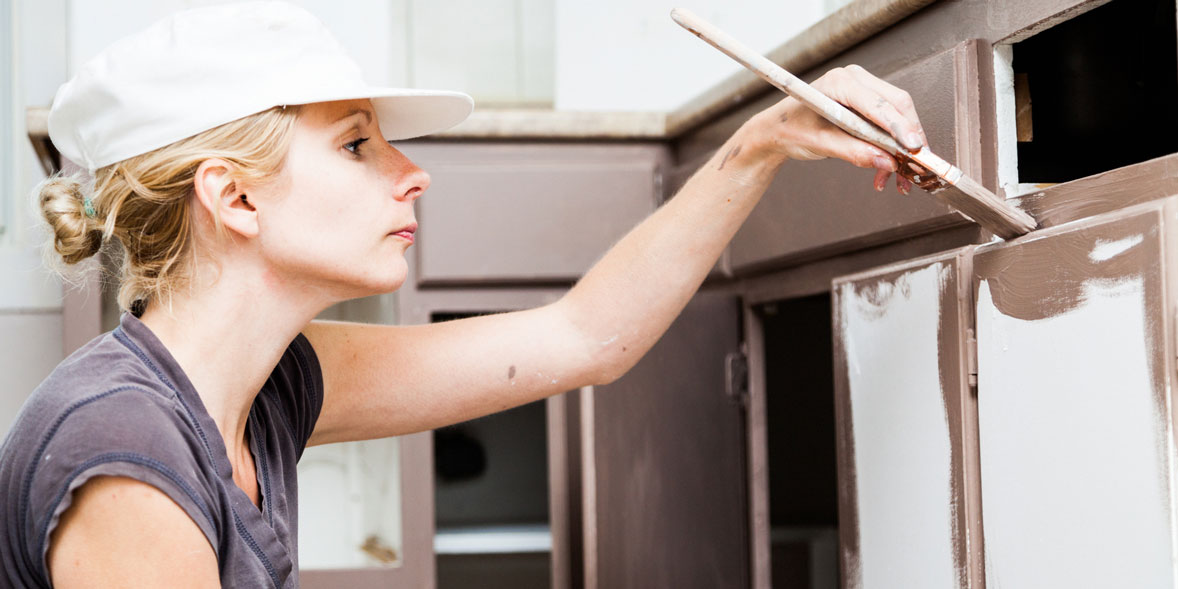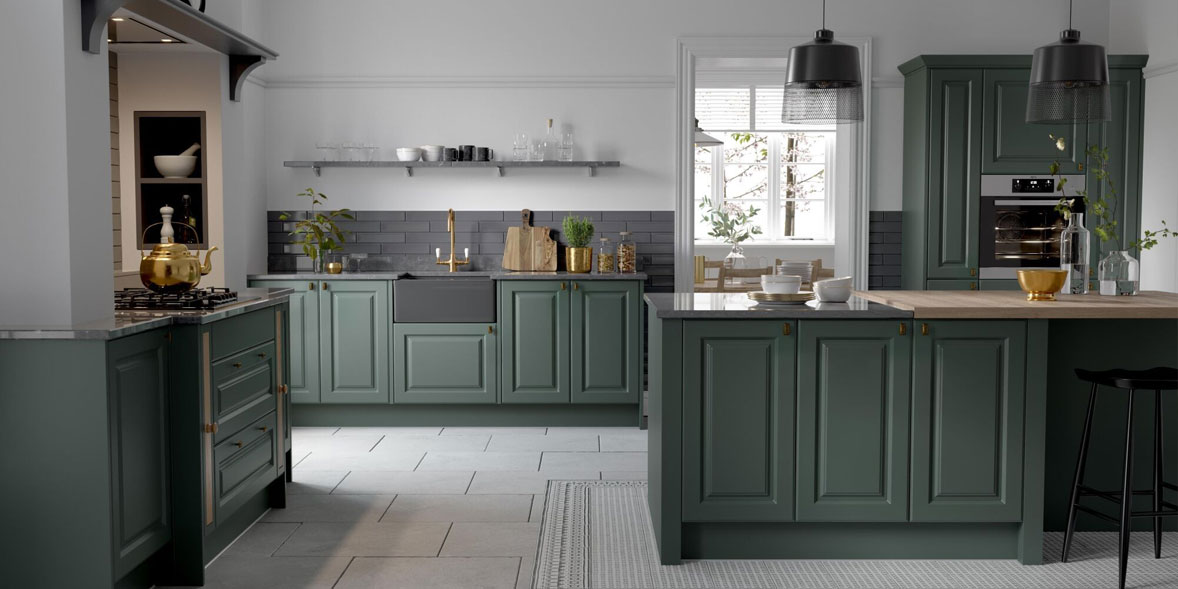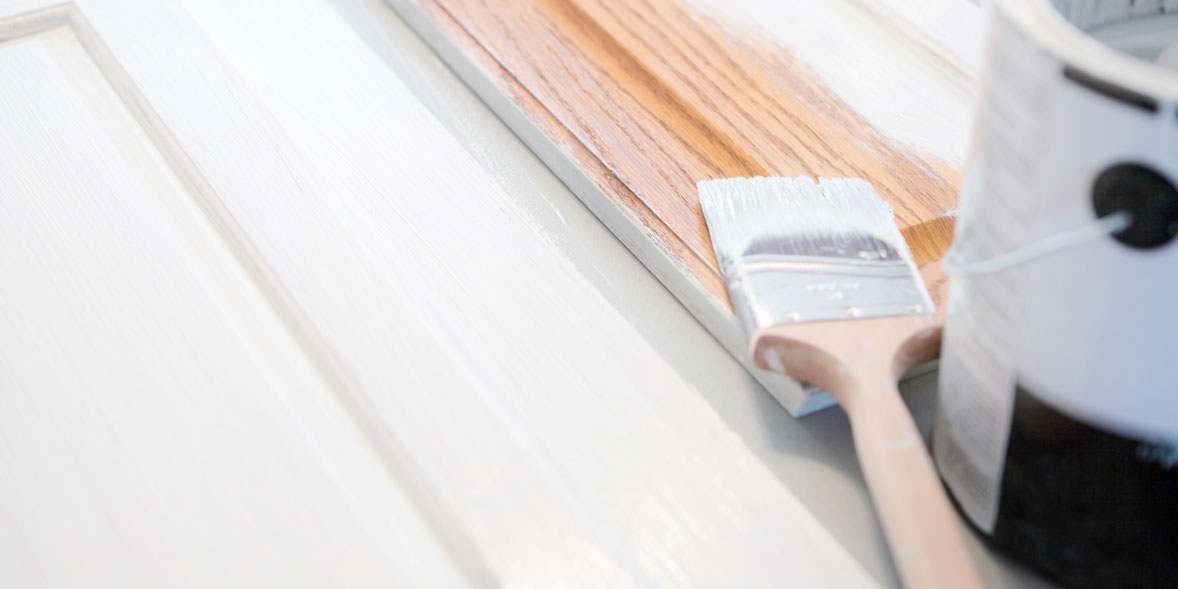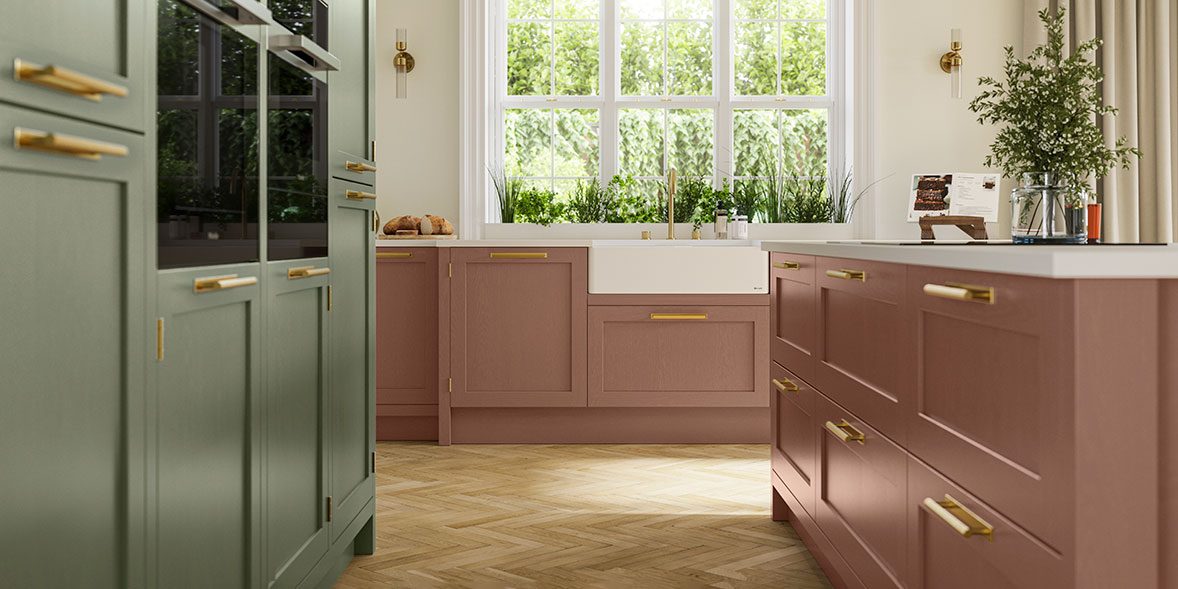By clicking a retailer link you consent to third-party cookies that track your onward journey. This enables W? to receive an affiliate commission if you make a purchase, which supports our mission to be the UK's consumer champion.
How to paint kitchen cabinets

The process of painting kitchen cupboards isn’t easy, but it can save you a lot of money.
Every year, the Building Cost Information Service (BCIS) provides us with typical costs for home improvement projects, including kitchen renovations – and they aren't cheap.
But there are things you can do to give your kitchen a new lease of life on a budget. Not only is painting your cabinets cheaper than replacing them, it's also more sustainable.
Here, we guide you through the process of painting kitchen cabinets – and how much it's likely to cost – with expert tips from Which? Trusted Traders and advice from DIYers.
Find out how much a new kitchen costs in 2025
Can I paint my kitchen cabinets myself?
Before you paint your cabinets, ensure they're structurally sound and you're happy with the layout.
You can do minor fixes when you're painting, such as covering small nicks and adjusting doors and drawer fronts, but large-scale damage might not be possible to fix.
You should also weigh up whether it's worth the time and money required to paint your cabinets if the layout isn’t working – especially if you plan to replace them at a later date.
We spoke to 11 Which? Trusted Traders to get their advice on painting kitchen cabinets.
The majority of traders said painting your cabinets is only possible for people with an intermediate or advanced level of DIY skills (64%).
Furthermore, most (73%) reported that they had been called out to fix cabinets that DIYers had attempted to paint themselves. The issues were usually caused by not prepping the cabinets properly.
So before you start, be honest with yourself about your level of capability.
How to paint kitchen cabinets

We spoke to 11 Which? Trusted Traders for advice on how to paint kitchen cabinets and get the perfect finish. They recommended the following steps.
1. Check your cabinet finish
Before you start, find out what type of kitchen cabinet finish you have. This will determine the paint you need and the process to follow.
Paint needs to be able to stick to the surface of the kitchen cupboard. The smoother the surface, the harder it is for the paint to stick, meaning it will be more prone to chipping.
Broadly, there are three types of kitchen finish:
- Wood or painted wood cabinets - because wood is quite coarse, it's easy to paint. You'll get the best results painting this type of cabinet.
- Laminate-wrapped cabinets - these kitchens are made of MDF or chipboard wrapped in laminate. You can paint these cabinets provided you use a good-quality, shellac-based primer.
- Plastic or vinyl-wrapped cabinets - these cabinets are also made of MDF or chipboard, but they're wrapped in plastic or vinyl. Of all the finishes, this is the smoothest. We don't recommend painting these cabinets, as you’ll struggle to get a durable result.
2. Gather your supplies
Here's everything you need for painting kitchen cabinets:
- Multipurpose degreaser
- Filler
- Sandpaper (120 grit)
- Sanding block or orbital sander
- Dust mask
- Primer
- Top coat
- Paint brush and tray
Some optional extras include:
- Small plastic bags to store any handles and hardware
- Painters tape to protect walls, tiles and appliances
- Dust cloths to cover the floor
- Microfibre or tack cloth to remove dust after sanding
- Saw horses or painting stands/pyramid risers to rest the doors on when painting
If you're painting wood, you'll need a sealant, or a primer that contains sealant.
3. Prepare the cabinets and the area
Prepare the area by laying dust sheets and ensuring you have adequate ventilation.
Remove all the doors and hardware (handles and hinges), and mark which doors and hardware items correspond to which cabinet.
Number all the cabinets and doors, and then put your hinges and handles into small bags labelled with the cabinet number.
If necessary, cover the walls around your cabinets with painters tape.
There are a lot of good videos and information on Instagram from painting companies. It’s worth looking into them when considering doing this job yourself.
4. Degrease your cabinets
According to Dom Pearson, from Pearson's Home Improvements, this is one of the most important steps in the process.
‘Over years of use, grease and grime will build up on your kitchen – this can’t be removed with normal soap,’ says Dom. ‘You'll need to use a general purpose degreaser to get your cabinets clean.’
If you don’t degrease properly, the paint will separate on your cabinet, making a textured finish. It will also impact the durability of your paint.
5. Fill in any holes
Use wood filler to fill any nicks or dents in your cabinet.
6. Sand down the cabinets
‘The aim of this step is not just to smooth the filler, but also to slightly roughen the surface of your cabinet,’ says Dom. ‘This gives the paint something to stick to.’
Painted wood cabinets are the easiest finish to sand – all you need to do is roughen the paint a little.
For plain or varnished wood cabinets, you'll need to sand until you've removed old varnish and the finish is a little rough.
For laminate-wrapped cabinets, sand until the surface of the cabinet is matt rather than satin. You're aiming to remove the finish of the laminate, not the laminate itself.
7. Treat plain wood
If you're painting plain wood, you'll need to seal it before you paint. Without sealant, oil from the tannins in the wood can seep through and create dark spots on your paint.
If you're painting hardwood, you'll need to seal the whole cabinet. If you're painting softwood, you'll need to seal the knots.
Alternatively, you can look for a primer that also contains a sealant.
8. Prime the surfaces
Once you've sanded, it’s time to prime. Remember that primer is what enables your paint to stick, so it’s important to get this right.
‘I recommend doing a patch test with primer in a small corner of your cabinet,’ says Dom. ‘This will allow you to check whether your cabinets are prepped well.’
If you're painting hardwood or laminate, use a shellac primer, as this is better at adhering to slippery surfaces.
If you're painting softwood or painted wood, a water-based primer should work.
9. Apply a top coat
This is the most fun part of the process, and where you'll really see the results of your preparation.
Apply the paint in thin layers and allow it to fully dry before adding the next layer.
You can add as many layers as you need to achieve your desired finish.
'Remember that all your top coat will do is change the colour of your cabinet. It won’t create a smooth finish or cover any faults,' says Dom. 'That means your cabinets need to be in almost perfect condition before you start adding colour.'
'You should also bear in mind that professional-standard paints take about three weeks to finish curing. For the best results, touch the paint as little as possible, and try to avoid getting grease on the surface. It's best to avoid frying oily foods if you can.'
Decided against painting your cabinets yourself? Use Which? Trusted Traders to find a reliable professional near you.
Best paint for kitchen cabinets

You need two types of paint for this process – primer and top coat.
The primer is really important, because that’s what sticks to the surface of your cabinet. Shellac-based primers are better at adhering to surfaces without much grip (which is why they are necessary for laminate and hardwood cabinets), but water-based options are generally easier to work with.
For the top coat, use a paint designed for wooden surfaces.
You'll need around 5 litres of both primer and top coat to paint a medium-sized kitchen (approximately 10 units).
You also need to choose between using professional and standard-quality paints. Professional paints are more expensive, but all of our traders recommended them over standard paints.
Professional grade paints are a must if you want the result to be long lasting. The extra cost is often balanced out as you use fewer coats than with standard paints.
The 11 traders we spoke to recommended the following brands of primer and paint. Bear in mind that we haven't tested these products.
Primer:
- Zinsser B-I-N. Available from major DIY retailers, including Amazon, Wickes, or B&Q
- Zinsser B-I-N Aqua. Available from Amazon or B&Q
Paint:
- Tikurilla Helmi. Available from retailers including Amazon, B&Q or The Paint Shed
- Benjamin Moore Scruff-X. Available from professional retailers including The Paint Shed
- Renner. Available from professional retailers including All Finishes
How much does it cost to paint kitchen cabinets?
Two main factors will determine the cost of painting your kitchen cabinets: the size of your kitchen and the quality of the products you choose.
Not including paint, we estimate that buying everything in the supplies list below will cost around £100-£110.
Paintbrushes and degreaser are the most expensive items you need – expect to spend around £20 on each. You can buy cheaper brushes but this will impact the finish of your cabinets.
Regarding paint, you can choose between standard and professional-quality products. If you're painting a 10-unit kitchen, you'll need around 5 litres of paint.
You can pick up this quantity of standard-quality primer and top coat for around £20 each. Approximately 5 litres of professional-standard paint and primer will cost you, at most, £100 each.
This brings your totals to around £150 with standard-quality paint or £300 with professional-quality paint.
Best kitchen cabinet paint colours

When deciding on the colour of your kitchen cabinets, you first need to consider the style of your kitchen.
If you want a modern and sleek finish, consider light, clean colours, like white. Alternatively, for a more homely feel, you can opt for darker colours like deep greens and blues.
At this point, it's also important to think about the size of your kitchen, and the amount of natural light it gets.
Darker colours can work in smaller spaces, but without a lot of natural light, they can make them feel small and oppressive.
You should also consider the resale value of your kitchen. If you are planning to sell your home in the short- or medium-term, it is better to opt for a more neutral colour for your kitchen cupboards. This will be more appealing to a greater number of buyers.
Finally, also think about the amount of upkeep you are willing to do. Remember that the finish of your kitchen will wear over time, and this will be much more obvious if you opted for a statement colour.
If you don't want to do touch-ups every few months, a neutral colour is a better choice.
If you think it's best to go for a neutral colour for your units, but still want a dramatic or homely kitchen, consider switching up your accessories - like your backsplash, lightshades, and wall art.
We consulted kitchen design experts to find out the top 5 kitchen trends for 2025
Spraying kitchen cabinets
If you are willing to invest a little money into DIY-ing your painted kitchen units, or you have a large number of units to paint, then it might be worth considering a paint sprayer.
Spray painting your kitchen cabinets will not only significantly reduce the amount of time you will spend painting, but it will achieve a better finish (if you use the sprayer correctly).
The process for spraying your kitchen cabinets is the same as painting, but instead of using a brush or roller for your primer and paint, you will spray it on.
You do need a little more space for this job, as you need to set up a 'painting booth'. This means a small, well-ventilated booth made of plastic film, which will catch the overspray.
Painting different types of kitchen cabinets
The process for painting your kitchen cabinets will vary slightly depending on the material of your cabinet.
Here we offer our top tips for painting your units.
Repainting painted cabinets
These are the easiest type of cabinet to paint - provided they are done in a neutral colour.
If you are repainting a darker shade of painted cabinet, then you will need to use more layers of primer.
Ensure you return your cabinetry to a neutral base, or the final colour of your cabinet will be altered by the paint underneath.
Painting wood kitchen cabinets
If you have an unpainted wooden kitchen, and you are planning to sell your house in the short- or medium-term, painting plain wood cabinets may not be advisable - especially if you are planning to DIY your units.
Anything less than a perfect result is likely to reduce the resale value of your kitchen.
In addition, the current trends for kitchens are focused on natural, homely aesthetics, meaning that wood is very popular.
Finally, buyers are more likely to prefer cabinetry that they can customise to their own tastes, rather than cabinets that they may struggle to refinish.
However, if you are happy to go for it, this should be a relatively easy job (compared to painting laminate cabinets). Just ensure you use a good quality sealant to prevent the oils in the wood affecting the paint.
Painting laminate kitchen cabinets
Painting laminate cabinets is much more difficult than wood - and it's hard to get a lasting result.
Consider your appetite for maintenance before you start. If you aren't happy to touch up your cabinets semi-regularly, it might be best to leave this project.
Remember, the goal when painting your laminate cabinets is not to remove the laminate. If the finish is already peeling or bubbling, unfortunately you aren't going to be able to fix this.
However, if you're looking for a cheerful refresh rather than perfection, this can be a great way to adapt your kitchen to your own style. Just remember to sand well and use a good quality primer.
Painting MDF kitchen cabinets
If you are repainting an MDF cabinet you first need to check on the type of finish. MDF cabinets are wrapped in either laminate (see above), plastic or vinyl.
Whilst you can get a good result repainting laminate, we don't recommend painting plastic or vinyl. These surfaces are so slick that you are unlikely to get a good result.
Thinking of replacing your cabinets? Find out how to choose the best kitchen worktops and cabinets
Tips from DIYers
As well as talking to our experts, we also spoke with 48 Which? members who have either painted their cabinets themselves or had them painted by a professional.
In total, 77% were satisfied with the result, while 19% were dissatisfied.
The most common issue reported was that the paint had started to peel, chip or degrade (31%). We surveyed people who painted their cabinets up to five years ago, so some amount of wear and tear is to be expected.
We spoke to three Which? members in more depth to find out more about the process and the results.
I spent less than £150 and around 10 hours repainting my cabinets
David, Durham
'I wanted a new colour for my kitchen but I didn't want to replace my cabinets as that would have meant replacing the Corian worktop,' said David. 'I decided to repaint the existing cabinets by myself.
'It was a fairly straightforward job and the finish is excellent – even more durable than some of the original covering. I spent less than £150 and completed the task in around 10 hours.
'My advice is to prepare your cabinets properly and always use a good primer. I'm really satisfied overall and would repaint my cabinets again if necessary.'
We refreshed our old kitchen, fixed our water damage, and saved money
Kevin, Somerset
'We inherited a varnished wood kitchen in late 2018 when we moved into our home,' said Kevin. 'The original cabinets were very good quality and we were happy with the layout.
'In 2019 we decided to refresh the kitchen using a local company. We removed some unnecessary decorative mouldings, refurbished the drawer runners, changed the worktop and repainted the units in pale grey.
'This year, after some water damage, the painter repainted the base units a deep green colour. This cost around £2,000 in total.
'The paint is chipping slightly around some of the handles on the base units, but overall I am satisfied with the work. We have a customised kitchen – and it was much cheaper than buying new.'
I repainted my cabinets to preserve my old kitchen
Richard, Surrey
'We bought a new cream kitchen from Howdens in 2007,' said Richard. 'We decided a couple of years ago that, although we were still very happy with the cabinets and the layout, they needed a refresh.
'I repainted them dark blue and I am still satisfied with how it’s holding up. However, the finish isn't perfect, and I am going to have a second coat of colour added when we next have a painter in.
'If I could redo it, I would definitely use an undercoat to help the colour stick.
'Overall I am satisfied with the cabinets. It cost me around £60 to paint them in total, and I would do it again if necessary in the future.'
Be inspired to make home improvements. Sign up for our Home newsletter – it's free monthly
This article uses insights from the Which? Connect panel, collected from research activities with our members. Find out how to get involved